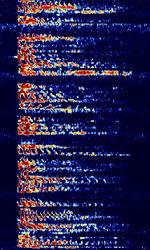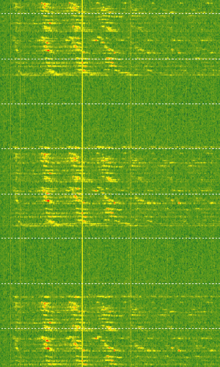Single Sideband Voice
Single-sideband voice is a subtype of amplitude-modulated voice which only uses one sideband and typically lacks a reference carrier as well—this case is referred to as single-sideband suppressed carrier (SSBSingle-sideband modulation-SC). The sideband used may be either the lower or upper sideband—lower sideband is typically used by amateurs for voice below 10 MHzMegaHertz (MHz) 10^6 Hz, and USBUpper Side Band Modulation (Radio, referring to reception and modulation mode)Universal Serial Bus (Computer, referring to USB Ports and cables) by amateurs for voice above 10 MHzMegaHertz (MHz) 10^6 Hz. SSBSingle-sideband modulation is utilized heavily for amateur HFHigh Frequency (3-30 MHz) voice communications as well as VHFVery High Frequency (30-300 MHz) and UHFUltra High Frequency (300-3000 MHz) weak signal voice communications. Single-sideband uses less power than full amplitude modulation, as it omits the carrier and duplicate sideband, both being superfluous to adequate voice communication in many situations. It is also more spectrally efficient than full AMAmplitude Modulation, as the omission of a carrier and duplicate sideband considerably decreases the utilized bandwidth. This comes at the expense of lower audio fidelity, as well as the need more careful receiver tuning due to the lack of a reference carrier signal. An improperly tuned SSBSingle-sideband modulation signal may sound distorted—either too high or too low in pitch. This is corrected by fine tuning adjustment. Some rigs have a "clarifier," also known as a receiver incremental tuner (RIT), which when used will only adjust the receive frequency and leave the transmit frequency as is. This feature can help avoid repeated adjustments for both sides of an amateur contact, and can also be used in nets to hear a slightly off-frequency operator with less hassle.
Hear RAF Volmet (USB Voice) Live at WebSDR Univ. of Twente (Alternate Frequency)[edit]
Samples[edit]
This example is of a USBUpper Side Band Modulation (Radio, referring to reception and modulation mode)Universal Serial Bus (Computer, referring to USB Ports and cables) voice aircraft VOLMET (weather information service).
Frequencies[edit]
SSBSingle-sideband modulation voice is extremely common throughout all HFHigh Frequency (3-30 MHz) amateur bands which allow the use of phone modes in at least some portion of the band. In general, United States Technician licensees only have HFHigh Frequency (3-30 MHz) phone privileges in a small section of the 10-meter band (28300 to 28500 kHzKiloHertz (kHz) 10^3 Hz). SSBSingle-sideband modulation voice may also be seen above 30 MHzMegaHertz (MHz) 10^6 Hz, where it is used instead of narrow FMFrequency Modulation voice due to its comparatively better weak signal performance.
Notable Users[edit]
High Frequency Global Communications System[edit]
This is a United States Air Force system. HFHigh Frequency (3-30 MHz)-GCS stations tend to operate in the aviation bands clustered around 5, 8 and 11/12 MHzMegaHertz (MHz) 10^6 Hz, although other frequencies are in use. The primary HFHigh Frequency (3-30 MHz)-GCS voice frequencies are 4724.0 kHzKiloHertz (kHz) 10^3 Hz, 6739.0 kHzKiloHertz (kHz) 10^3 Hz, 8992.0 kHzKiloHertz (kHz) 10^3 Hz, 11175.0 kHzKiloHertz (kHz) 10^3 Hz, 13200.0 kHzKiloHertz (kHz) 10^3 Hz and 15016.0 kHzKiloHertz (kHz) 10^3 Hz. In addition to the HFHigh Frequency (3-30 MHz)-GCS, U.S. aircraft frequently use Military Affiliate Radio System (MARS) HFHigh Frequency (3-30 MHz) stations (13927.0 kHzKiloHertz (kHz) 10^3 Hz) and Canadian Forces HFHigh Frequency (3-30 MHz) stations (11232.0 kHzKiloHertz (kHz) 10^3 Hz) to relay messages.
The system uses Upper Sideband Voice and is used to communicate with aircraft in flight, ground stations and some United States Navy surface assets. All worldwide receiving and transmitting sites in the HFHigh Frequency (3-30 MHz)-GCS system are remotely controlled from Andrews Air Force Base. [1]
Emergency Action Message (EAM):[edit]
This is a system used by the US Military to direct nuclear capable forces to execute an operation. This sound file was recorded at 11.175 MHzMegaHertz (MHz) 10^6 Hz (Female Voice, Mainsail to Skyking) on 05-20-14 at 0035 UTC.
Additional Links[edit]
- Emergency Action Message with Skyking
- EAM Message at 11.175 KHz Male Voice, Mainsail to Midas Touch
- (EAM's Number Station Tag)
- Emergency Action Message - Wikipedia
Video Examples[edit]
- RTL SDR R820T 10 meter SSB receiving
- SSB Amateur Ham Radio with RTL SDR (RTL2832), Nooelec Ham It Up Upconverter and SDR Sharp



